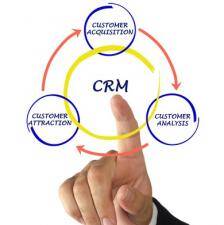 I attended Convergence for a short time this week. It was a good show, nearly 12,000 people clamoring to learn as much as possible about Microsoft Dynamics (all of the flavors, not just CRM)… Well, clamoring may be a tad exaggerated, but the users I talked to all had interesting stories to tell and were happy to be there.
I attended Convergence for a short time this week. It was a good show, nearly 12,000 people clamoring to learn as much as possible about Microsoft Dynamics (all of the flavors, not just CRM)… Well, clamoring may be a tad exaggerated, but the users I talked to all had interesting stories to tell and were happy to be there.
 I attended Convergence for a short time this week. It was a good show, nearly 12,000 people clamoring to learn as much as possible about Microsoft Dynamics (all of the flavors, not just CRM)… Well, clamoring may be a tad exaggerated, but the users I talked to all had interesting stories to tell and were happy to be there. (Side note: it was in New Orleans, where even if you go to the worst restaurant in town you will be happy — how can they not be happy? But I digress…)
I attended Convergence for a short time this week. It was a good show, nearly 12,000 people clamoring to learn as much as possible about Microsoft Dynamics (all of the flavors, not just CRM)… Well, clamoring may be a tad exaggerated, but the users I talked to all had interesting stories to tell and were happy to be there. (Side note: it was in New Orleans, where even if you go to the worst restaurant in town you will be happy — how can they not be happy? But I digress…)
Two things I learned in the short time I was there, and I think they are important enough to share:
First, Microsoft is finally (finally!) en route to having a competitive enterprise solution for CRM.
Why I say this? Not only functionality (although the Marketing Pilot demo I saw and the conversations I had showed they did improve the functionality greatly – at least on Marketing and Sales), but also because the implementations are getting done in larger, enterprise setups. In the old days (like 4-5 years ago, maybe) if you asked for the average deal size for Microsoft Dynamics CRM (the preferred spelling of their name by their branding people – don’t get caught saying MS CRM or even Microsoft CRM), it would’ve been around 25 people. That number now is in the low 200s. The number of larger implementations (1,000+ licenses) that are actually deployed is increasing, as are the stories that I heard. The performance and scalability that were hounding them in past versions is no longer an issue (according to their clients, not just their marketing department).
The functionality introduced, both via the fully-integrated Marketing Pilot that was done in around 6 months and the recently acquired NetBreeze, was good, complete, and the performance was competitive. The traction is not yet there, but the pipelines are quite well setup according to their sales people. If it continues this way, Microsoft will have more than one trick to play – and that is good for the market overall.
It would take an entire other post to talk about their potential (on the balance side: invest time and efforts in customer service — please!) and what they could likely do, so will do that in another post. If you want a more detailed explanation of what I think of Microsoft Dynamics CRM, I did this interview with Dennis Howlett of JD-OD.com.
But I want to make sure I tell you the other thing I learned while there – it was not related to technology, or Microsoft.
During a customer panel today they had a few CIOs and a marketing person. Apparently the CIO for that particular company could not make it and their marketing person had to step in. The coolest part was during the Q&A: they were very interesting people, all very advanced users of technology and they understood quite well the role that CIOs played in the organization as well as the LoB stakeholders.
I can’t precisely remember the question asked, but I remember the precise answer. One of the CIOs said (paraphrasing): “My job is to create a cloud infrastructure with the technology so that the LoB people can do what they need to do.” The Marketing person, sitting right next to him, said (also paraphrasing): “I don’t care where the application resides, who owns it, or how it works as long as I can do what I need to do and it fits with IT requirements.”
My ears perked when I heard that. Why?
We have been hearing ad-nauseam lately how the CMO cares about technology and the CIO is done and does not get it — these two people from different companies were saying something different. The CIO was important as the owner of the infrastructure and the LoB person was important for the functionality it required to do their job – but they both wanted to make sure the corporate infrastructure was leveraged and compliance was in place.
A deviation from the mantra of selling to Marketing and ignoring IT — they were both important.
I asked a follow-up question, the one that I have been fighting over many times the past few weeks: could Gartner’s prediction that the CMO was getting away from IT and spending tons of money in being independent be wrong? How about the overall assumption that the CIO was done, was that also a myth?
This is what I learned: the LoB person said that he needed IT to make sure what he ran (which he did not care where it lived) was compliant, integrated, and leverageable. The CIO said similarly, he did not care where the application lived as long as the data was under compliance and their control.
This is what is critical to understand as we get 2013 underway: there is no gigantic growth in technology budgets for CMOs – and what has increased is going to make sure what they do is in compliance with the rest of the organization. There is no decrease in responsibilities for CIOs, to the contrary – there is an increase, but it is very focused on building the infrastructure for cloud to SUPPORT the LoB.
You may say that this was an exception, and you may be correct, but even a broken clock is right twice a day — which means that even as an exception, it is highlighting what few of us have been saying for a while now… CMO’s ain’t becoming rich, and IT still matters.
What say you? Am I wrong? Right? Meh? Say Something!
Disclaimer: Microsoft invited me to the event, picked up my trip, hotel, conference fees, fed me (well, lunch on Wednesday was not considered food – but I blame the convention center, not Microsoft) and gave me access to executives and virtually anyone I wanted. They were a client in the past and are likely to become one again in the future – and yet, if they did not do things right I would’ve call them on it as I did the past 3-4 years. Credit where credit is due, the product is getting better.






